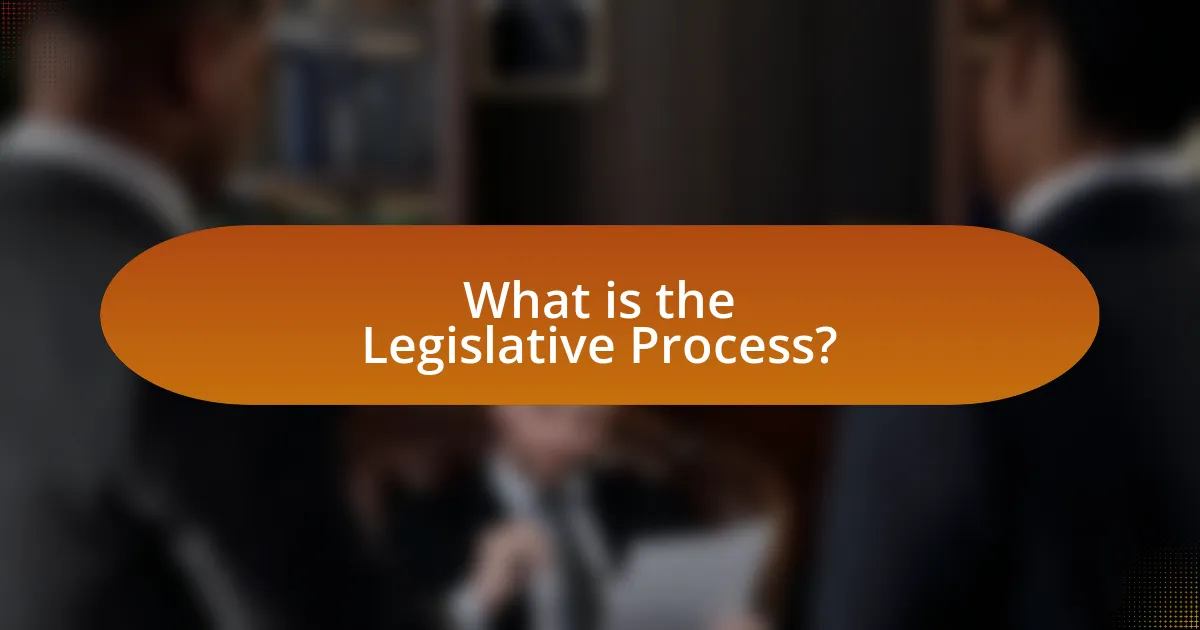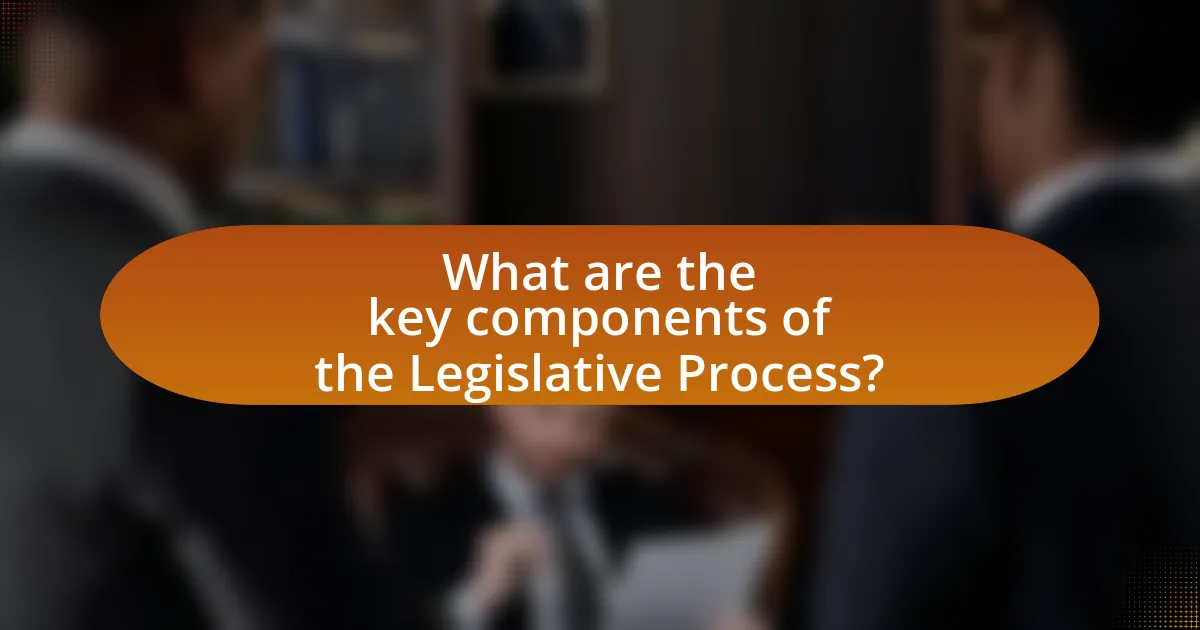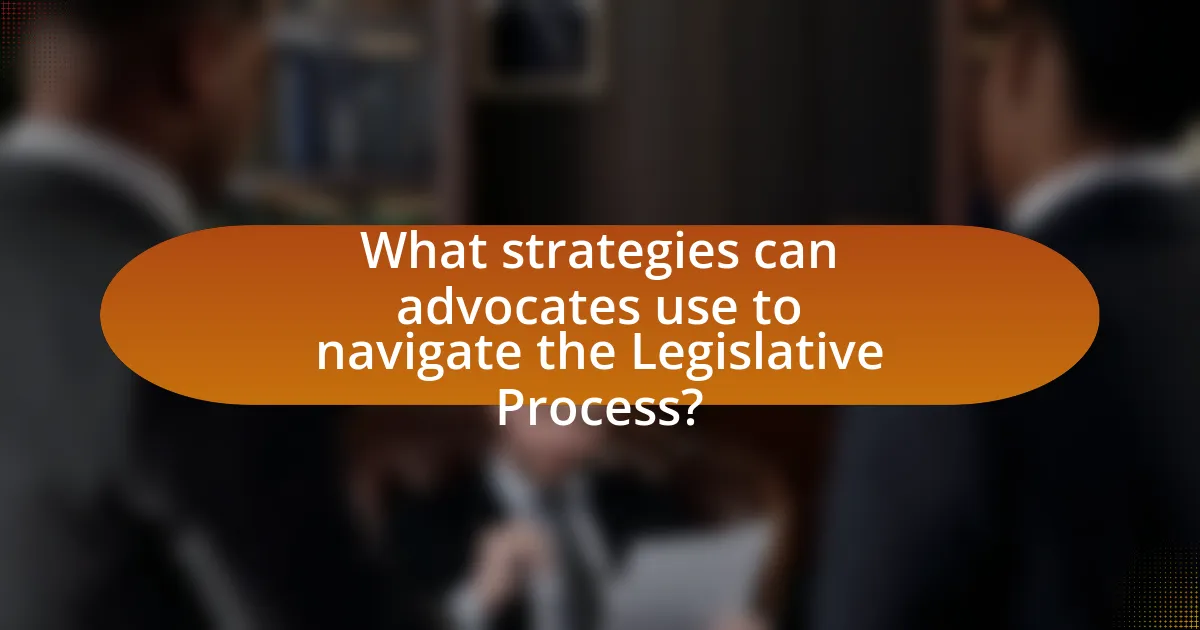The article “Understanding the Legislative Process: A Guide for Advocates” provides a detailed examination of the legislative process, focusing on how proposed laws, or bills, are introduced, debated, amended, and voted on within a legislative body, such as the U.S. Congress. It outlines the key stages of this process, including introduction, committee review, floor debate, voting, and presidential action, while emphasizing the interaction between different branches of government. Additionally, the article highlights the importance of understanding this process for advocates, detailing strategies for effective communication, coalition-building, and overcoming challenges in legislative advocacy. It also discusses the role of technology and available resources that can assist advocates in navigating the complexities of legislation.

What is the Legislative Process?
The legislative process is the procedure through which proposed laws, known as bills, are introduced, debated, amended, and voted on by a legislative body, such as Congress in the United States. This process typically begins with the introduction of a bill, followed by committee review, floor debate, and voting in both chambers of the legislature. For example, in the U.S. Congress, a bill must pass through the House of Representatives and the Senate before being sent to the President for approval or veto. The legislative process is governed by specific rules and procedures that ensure thorough examination and discussion of proposed legislation, reflecting the democratic principles of representation and accountability.
How does the Legislative Process function in a democratic system?
The legislative process in a democratic system functions through a series of structured steps that facilitate the creation, amendment, and repeal of laws. Initially, a proposed law, known as a bill, is introduced by a member of the legislature. This bill undergoes a series of readings and debates, allowing legislators to discuss its merits and implications. Following these discussions, the bill is subject to committee review, where it may be amended or rejected based on detailed examination.
Once the committee approves the bill, it is brought back to the full legislative body for further debate and voting. If the bill passes in one chamber, it moves to the other chamber for a similar process. If both chambers approve the bill, it is sent to the executive branch for approval or veto. This process ensures checks and balances, as it requires collaboration and consensus among various branches of government.
The validity of this process is supported by historical examples, such as the U.S. Congress, where the bicameral system and committee structures are designed to enhance deliberation and representation. Additionally, democratic principles dictate that public input and advocacy play crucial roles in shaping legislation, further reinforcing the accountability of elected officials.
What are the key stages of the Legislative Process?
The key stages of the Legislative Process are introduction, committee review, floor debate, voting, and presidential action. During the introduction stage, a bill is proposed in either the House of Representatives or the Senate. The committee review stage involves examination and possible amendments by a specialized committee. Following this, the floor debate stage allows for discussion among all members before the bill is voted on. The voting stage determines whether the bill passes in its respective chamber. Finally, presidential action involves the president signing the bill into law or vetoing it. These stages are essential for transforming proposed legislation into enacted law, as outlined in the U.S. Constitution and legislative procedures.
How do different branches of government interact during the Legislative Process?
Different branches of government interact during the Legislative Process through a system of checks and balances, where the legislative branch proposes and debates laws, the executive branch enforces those laws, and the judicial branch interprets them. For example, Congress, as the legislative branch, drafts and votes on legislation, while the President, representing the executive branch, has the power to sign or veto bills. Additionally, the Supreme Court, part of the judicial branch, can review laws to ensure they comply with the Constitution, thereby influencing the legislative process. This interaction ensures that no single branch holds excessive power, maintaining a balance that is fundamental to the functioning of democracy.
Why is understanding the Legislative Process important for advocates?
Understanding the Legislative Process is crucial for advocates because it enables them to effectively influence policy decisions and promote their causes. By comprehending how laws are made, advocates can identify key decision-makers, engage in strategic lobbying, and mobilize public support at critical stages of the legislative process. For instance, knowledge of committee structures and timelines allows advocates to time their efforts for maximum impact, as evidenced by successful campaigns that have resulted in significant legislative changes, such as the passage of the Affordable Care Act in 2010, which was driven by organized advocacy efforts that navigated the legislative landscape.
How can knowledge of the Legislative Process empower advocacy efforts?
Knowledge of the Legislative Process empowers advocacy efforts by enabling advocates to navigate and influence policy-making effectively. Understanding the stages of legislation, such as drafting, committee review, and voting, allows advocates to identify key opportunities for engagement and intervention. For instance, advocates can strategically time their outreach to coincide with critical decision points, increasing the likelihood of their issues being addressed. Additionally, familiarity with the roles of legislators and the importance of public opinion can help advocates tailor their messaging and mobilize constituents to support their causes. This strategic approach is supported by research indicating that informed advocacy leads to higher success rates in influencing legislative outcomes.
What role do advocates play in shaping legislation?
Advocates play a crucial role in shaping legislation by influencing policymakers and public opinion to promote specific issues or causes. They engage in activities such as lobbying, grassroots mobilization, and public education to ensure that their perspectives are considered in the legislative process. For instance, organizations like the American Civil Liberties Union (ACLU) actively lobby for civil rights legislation, demonstrating how advocates can directly impact the creation and modification of laws. Their efforts often lead to increased awareness and support for particular legislative initiatives, ultimately affecting the outcomes of policy decisions.

What are the key components of the Legislative Process?
The key components of the Legislative Process include the introduction of a bill, committee review, floor debate, voting, and presidential approval. The introduction of a bill marks the beginning of the legislative journey, where a proposed law is presented in either the House of Representatives or the Senate. Following this, the bill undergoes committee review, where it is examined, amended, and voted on by a smaller group of legislators. If the bill passes the committee stage, it moves to the floor debate, where all members discuss its merits and propose further amendments. After debate, a vote is conducted; if the bill receives majority support, it advances to the other chamber for a similar process. Finally, if both chambers approve the bill, it is sent to the president for approval or veto. This structured process ensures thorough examination and debate of proposed legislation, reflecting the democratic principles of representation and accountability.
What are the different types of legislation?
The different types of legislation include statutory law, administrative regulations, and case law. Statutory law consists of laws enacted by a legislative body, such as Congress or state legislatures, which are formally written and codified. Administrative regulations are rules created by governmental agencies based on statutes, providing detailed guidelines for implementing laws. Case law, derived from judicial decisions, interprets statutes and regulations, establishing legal precedents that influence future cases. Each type plays a crucial role in the legislative process, shaping the legal framework within which society operates.
How do bills differ from resolutions in the Legislative Process?
Bills and resolutions differ primarily in their purpose and legal effect within the legislative process. Bills are formal proposals for new laws or amendments to existing laws that require approval from both legislative chambers and the executive branch to become law. In contrast, resolutions are typically used to express the sentiments or opinions of the legislative body, address internal matters, or make procedural decisions, and do not have the force of law. For example, a bill must go through a series of steps including committee review and voting, while a resolution can often be adopted with a simple majority and does not require the same level of scrutiny or approval from the executive.
What is the significance of amendments in legislation?
Amendments in legislation are significant because they allow for the modification, improvement, or clarification of proposed laws. This process ensures that legislation can adapt to changing societal needs, address concerns raised during debates, and incorporate expert opinions or new information. For instance, the U.S. Constitution allows for amendments to be proposed and ratified, reflecting the evolving values and priorities of society, as seen with the Civil Rights Amendments, which aimed to rectify injustices and expand rights. Thus, amendments play a crucial role in enhancing the effectiveness and relevance of laws.
How does the committee system work within the Legislative Process?
The committee system is a crucial component of the legislative process, functioning as a mechanism for reviewing, amending, and recommending legislation. Committees, composed of members from the legislative body, specialize in specific areas such as finance, education, or health, allowing for detailed examination of proposed bills. This specialization enhances the efficiency and effectiveness of the legislative process by enabling in-depth discussions and expert testimonies.
For instance, in the United States Congress, there are standing committees that handle ongoing legislative issues, while select committees may be formed for specific tasks. According to the Congressional Research Service, approximately 90% of bills introduced in Congress do not make it to the floor for a vote, often due to committee decisions. This illustrates the significant role committees play in shaping legislation, as they can either advance bills to the full chamber or halt them through various processes, such as hearings, markups, and votes.
What are the functions of committees in reviewing legislation?
Committees play a crucial role in reviewing legislation by conducting detailed examinations of proposed bills, gathering information, and making recommendations. They analyze the content of legislation, hold hearings to collect testimonies from experts and stakeholders, and assess the potential impacts of the bills. This process allows committees to identify issues, suggest amendments, and ultimately determine whether a bill should advance to the full legislative body for further consideration. Committees ensure that legislation is thoroughly vetted, which enhances the quality of laws enacted.
How can advocates influence committee decisions?
Advocates can influence committee decisions by providing expert testimony, mobilizing public support, and engaging in strategic lobbying. Expert testimony allows advocates to present data and personal stories that highlight the importance of specific issues, thereby shaping committee members’ perspectives. Mobilizing public support through campaigns can create pressure on committee members to align with constituents’ interests, as seen in various advocacy efforts that have swayed legislative outcomes. Strategic lobbying involves direct interactions with committee members to discuss policy implications and persuade them to consider specific viewpoints, which has been shown to be effective in numerous legislative contexts.

What strategies can advocates use to navigate the Legislative Process?
Advocates can navigate the Legislative Process by employing strategies such as building relationships with lawmakers, understanding the legislative calendar, and utilizing data-driven arguments. Building relationships with lawmakers fosters trust and opens communication channels, which can lead to more effective advocacy. Understanding the legislative calendar allows advocates to time their efforts strategically, ensuring that they engage with lawmakers when they are most receptive. Utilizing data-driven arguments strengthens the advocate’s position by providing concrete evidence that supports their cause, making it more compelling to legislators. These strategies are validated by successful advocacy campaigns that have effectively influenced legislation through relationship-building, strategic timing, and the use of robust data.
How can advocates effectively communicate with legislators?
Advocates can effectively communicate with legislators by clearly articulating their positions and providing relevant data to support their arguments. This involves preparing concise, fact-based messages that highlight the importance of the issue at hand, utilizing statistics or case studies to demonstrate the potential impact of proposed legislation. For instance, a study by the National Conference of State Legislatures indicates that personal stories combined with factual evidence significantly enhance the persuasiveness of advocacy efforts. Engaging in direct conversations, attending town hall meetings, and utilizing social media platforms also facilitate meaningful dialogue, allowing advocates to build relationships and foster trust with legislators.
What are best practices for drafting advocacy letters or emails?
Best practices for drafting advocacy letters or emails include being clear and concise, addressing the recipient appropriately, and providing specific requests or actions. Clarity ensures that the message is easily understood, while conciseness respects the recipient’s time. Addressing the recipient by name and title personalizes the communication, increasing the likelihood of engagement. Specific requests, such as asking for support on a particular bill, provide a clear direction for the recipient’s response. Additionally, including relevant facts or statistics can strengthen the argument, making it more persuasive. For instance, a letter advocating for environmental legislation might cite data from the Environmental Protection Agency showing the benefits of clean air regulations.
How can personal stories enhance advocacy efforts?
Personal stories enhance advocacy efforts by creating emotional connections that resonate with audiences, making complex issues more relatable. When individuals share their experiences, they humanize abstract concepts, allowing policymakers and the public to understand the real-life implications of legislation. Research indicates that narratives can significantly influence attitudes and behaviors; for instance, a study published in the journal “Health Communication” found that personal stories increased support for health-related policies by 30%. This demonstrates that storytelling not only captures attention but also drives action, ultimately leading to more effective advocacy outcomes.
What tools and resources are available for advocates?
Advocates have access to various tools and resources that enhance their effectiveness in influencing legislative processes. Key resources include advocacy training programs, which equip advocates with skills in communication, negotiation, and strategic planning. Additionally, online platforms such as advocacy software facilitate campaign management, allowing for efficient organization of outreach efforts and mobilization of supporters. Research databases provide access to legislative information, policy analysis, and data that inform advocacy strategies. Furthermore, networking opportunities through professional organizations enable advocates to connect with peers and share best practices. These resources collectively empower advocates to navigate the legislative landscape effectively.
How can technology assist in tracking legislation?
Technology assists in tracking legislation by providing real-time updates, data analytics, and user-friendly platforms that consolidate legislative information. Tools such as legislative tracking software and mobile applications enable users to monitor bill progress, access legislative documents, and receive notifications about changes or votes. For instance, platforms like GovTrack and LegiScan aggregate data from various legislative bodies, allowing advocates to efficiently follow specific bills and their statuses. This technological integration enhances transparency and accessibility, empowering advocates to engage more effectively in the legislative process.
What organizations provide support for legislative advocacy?
Organizations that provide support for legislative advocacy include the American Civil Liberties Union (ACLU), the National Association of Social Workers (NASW), and the League of Women Voters. These organizations actively engage in lobbying efforts, provide resources for grassroots mobilization, and offer training for advocates to effectively influence legislation. For instance, the ACLU has a long history of advocating for civil rights through legislative channels, while the NASW focuses on social justice issues and policy reform in social work. The League of Women Voters empowers citizens to participate in government and advocate for policies that promote democracy.
What are common challenges advocates face in the Legislative Process?
Advocates commonly face challenges such as limited access to lawmakers, insufficient funding, and the complexity of legislative procedures. Limited access to lawmakers can hinder advocates’ ability to present their cases effectively, as personal relationships and direct communication are often crucial for influencing policy. Insufficient funding restricts the resources available for advocacy efforts, making it difficult to conduct research, mobilize supporters, or engage in public campaigns. The complexity of legislative procedures can create barriers, as advocates must navigate intricate rules and timelines to ensure their issues are addressed. These challenges are well-documented in studies highlighting the difficulties faced by advocacy groups in influencing legislation.
How can advocates overcome opposition to their proposals?
Advocates can overcome opposition to their proposals by employing strategic communication and coalition-building. Effective communication involves clearly articulating the benefits of the proposal and addressing concerns raised by opponents. For instance, research shows that framing proposals in terms of shared values can resonate more with diverse audiences, thereby reducing resistance. Additionally, forming coalitions with stakeholders who support the proposal can amplify the advocate’s voice and provide a united front against opposition. A study by the National Conference of State Legislatures highlights that successful advocacy often relies on building broad-based support, which can lead to increased pressure on decision-makers to consider the proposal favorably.
What strategies can be employed to build coalitions for support?
To build coalitions for support, advocates should employ strategies such as identifying common goals, engaging stakeholders, and fostering open communication. Identifying common goals ensures that all parties have a shared vision, which is crucial for unity. Engaging stakeholders involves reaching out to individuals and organizations that have a vested interest in the issue, thereby broadening the coalition’s base. Fostering open communication facilitates trust and collaboration among coalition members, allowing for effective problem-solving and decision-making. Research indicates that coalitions with clear objectives and strong communication channels are more successful in achieving their legislative goals, as evidenced by studies conducted by the National Council of Nonprofits, which highlight the importance of collaboration in advocacy efforts.
What practical tips can enhance advocacy in the Legislative Process?
To enhance advocacy in the legislative process, advocates should build strong relationships with legislators. Establishing trust and open communication with lawmakers increases the likelihood of support for advocacy initiatives. Research indicates that personal connections can significantly influence legislative outcomes, as legislators are more likely to respond positively to constituents they know and trust. Additionally, advocates should provide clear, concise information and data to support their positions, as evidence-based arguments are more persuasive in legislative discussions. For instance, presenting statistics or case studies relevant to the proposed legislation can effectively illustrate the potential impact of the policy. Engaging in grassroots mobilization, such as organizing community support and encouraging constituents to contact their representatives, also amplifies advocacy efforts. Studies show that when constituents express their views directly to legislators, it can sway decision-making processes.


